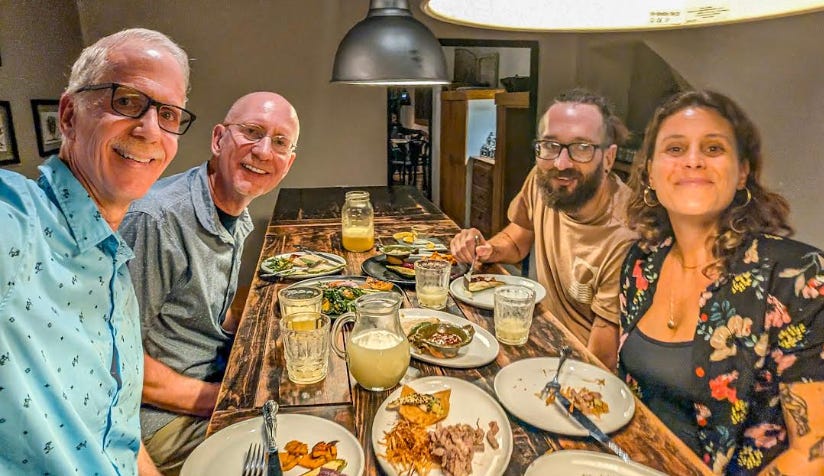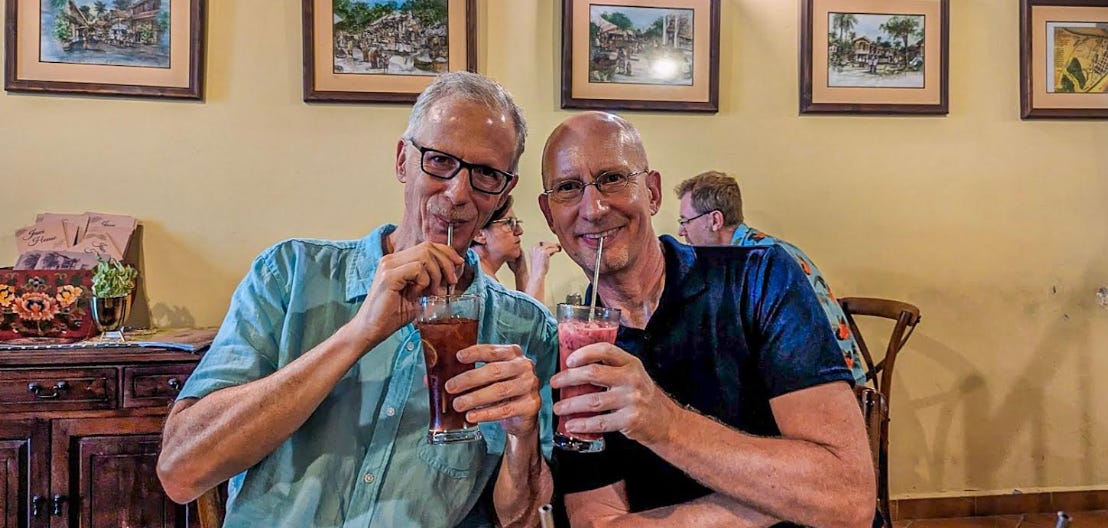Why Are Restaurants in America So Damn Expensive?
Eating out is much cheaper outside the United States. Why?
For the audio version of this article, read by the author, go here.
Before Michael and I left Seattle to become digital nomads, we used to eat at a mid-range restaurant near our house called Duke’s Seafood. We were poorer back then, more closely watching our pennies, so I remember a modest dinner for the two of us, with taxes and a 15% tip (but without alcohol or dessert), used to cost around $45 USD.
We stopped by the place on a recent visit back to Seattle, and I checked out the menu.
The same items we used to buy — with taxes and the now-expected 20% tip — cost just over $80.
That can’t possibly be right! I thought. Even adjusting for inflation — which has obviously been very high lately — the cost since 2010 should only have risen to $67.
If you included alcohol and dessert, the cost of a dinner for two at Duke’s was now well over a hundred dollars. It was twenty-six dollars for a bowl of clam chowder — thirty dollars in a damn bread bowl.
That’s insane! I thought.
I tried to remember the last time we’d spent anywhere near that much at a restaurant outside of America, even at posher places.
Look, I know that human beings are really bad at estimating things like “rising prices.” Nostalgia blinds us to a lot, like the fact that wages rise too — at least when you’re not a writer.
But I’m also not the first to point out that prices in American restaurants have skyrocketed: between 3.7% and 6.8% in just the last year — even higher than the rate of inflation. And this is on top of similar or higher increases every year since 2020.
And no, it’s not just restaurants in trendy urban areas. Prices have soared almost everywhere: $35 for a chicken dinner in Mississippi, $5 for a croissant in suburban Denver.
How much cheaper are restaurants outside of America? Why are prices rising now? And what does it all mean?
A restaurant meal costs how much outside of America?
It’s hard to make exact comparisons between restaurant prices in America and those in other regions of the world, because prices can vary dramatically even within a country or region, and exchange rates make a big difference too.
Also, many online comparisons don’t account for the fact that menu prices in America exclude taxes and that hefty 20% tip; in other countries, taxes are usually included in menu prices, and the expected tip is much smaller or nonexistent.
Considering all these factors, restaurant prices outside of America generally run:
10-20% cheaper in Canada and Western Europe.
20-60% cheaper in Central and Eastern Europe.
50-70% cheaper in Latin America.
40-90% cheaper in Asia and Southeast Asia.
This summer in Taiwan, for example, Michael and I had a fabulous meal at Taipei’s famous — and fairly upscale — Din Tai Fung dumpling house. Dinner for three was $62 USD, or just over $20 a person.
But Din Tai Fung now has outlets in the U.S. too, and I looked up the American price for the same meal (including taxes and tip): $135 — more than twice as much.
Of course, there are a few countries where restaurant prices are just as high as in America or even higher. I saw my first $25 hamburger in Switzerland — fairly common in America now, at least with taxes and tip, but this was back in 2019.
That said, before our 2024 visits to London, Norway, and the Netherlands, Michael and I were warned about those places’ sky-high restaurant prices, and we still found them lower than back in America.
It’s true that the same forces pushing prices higher in America are affecting restaurants worldwide. But at least they’re starting in a lower place.
Why are restaurant prices so high in America?
Let’s face it: America is a very wealthy country, with the third-highest salaries in the world (after, yes, Switzerland, and also Luxembourg).
Restaurant prices are tied to wages and the general cost of living, so it stands to reason that prices would be higher in the United States (and restaurants may be unusually expensive in Seattle).
At the same time, almost everything has become much more expensive in America lately. Inflation is a bitch — especially when wages don’t keep up.
There’s a reason why American voters are suddenly stampeding toward any politician who even mentions the “affordability” issue.
(What caused inflation? Covid disruptions and government stimulus before, and tariffs and a crackdown on immigration now.)
Anyway, thanks to labor, supply, and overhead costs, restaurateurs have truly had no choice but to raise their prices.
But not surprisingly, consumers are rebelling. It turns out most people don’t want to pay $25 for breakfast.
Across the board, consumers are shifting down to the next-cheapest dining option: full-service diners are moving to “fast-casual” restaurants, fast-casual diners are shifting to fast-food, and even fast-food diners are gravitating toward the value menu.
And almost everyone is eating out less.
This all cuts into profits, forcing prices higher still, which makes people even more price-conscious — and, well, you see the problem.
High-end restaurants are surviving by highlighting their “exclusivity” and social-media-friendly “experiences” — but it’s hard to see those tactics holding up after a stock market crash or a downturn in the housing market.
Some restaurateurs are fighting hard for price-resistant diners, experimenting with things like “ghost kitchens” — food outlets that increase efficiency by cooking for takeout or delivery-only.
Meanwhile, the Chili’s restaurant chain cut prices dramatically and saw sales explode. And even Duke’s — that seafood restaurant where Michael and I used to eat in Seattle — is offering some pretty aggressive coupons and a great happy hour.
But the math is bleak, and restaurants are still closing at a high rate. And formerly beloved chains like Denny’s, Applebee’s, TGI Fridays, and Red Lobster are either going bankrupt or closing stores en masse.
Another problem in America? “Cheap eats” means fast food.
One thing that almost every international visitor to America immediately notices is that it’s almost impossible to get a cheap meal that isn’t fast food.
Over the last fifty years, the American government has heavily subsidized beef, corn, and a few other crops, artificially lowering the cost of fast food and soda.
Problem is — and forgive me for sounding like such a snob — fast food tastes terrible, chock-full of salt, sugar, and fat. It’s also terrible for you, ultra-processed offerings that may be largely responsible for America’s obesity epidemic.
This isn’t the situation almost anywhere else in the world, where, rather than fast food restaurants everywhere, you’ll instead find a wide range of other cheap dining options — from street food, to food carts, to hole-in-the-wall restaurants. And the food is much more likely to be freshly cooked and locally sourced.
In Osaka, Japan, where we’re currently living, it’s possible to get any manner of fantastic “cheap” meals for five dollars or so — and outright fine dining for twenty or even ten dollars more. (The exchange rate is currently excellent.)
And yes, a meal at Din Tai Fung in Taiwan costs around $20 a person, but Michael and I found a little place down an alley near our apartment that offered similar soup dumplings for much less: about $4 a person — albeit in much more modest surroundings.
Meanwhile, unlike fast food, this food is frequently fantastic. One of the best meals we’ve ever eaten was the fish and shrimp skewers at Mariscos Vicky — a cluster of plastic chairs and tables under sun umbrellas and a grill literally on the beach in Puerto Vallarta, Mexico.
The cost of stuffing yourself with fresh fish, tortillas, rice, and beans? Six bucks.
Let’s also talk tipping in America.
By now, most people know all the arguments against America’s “tipping culture”: it’s annoying, it’s confusing, and all the rest.
But my biggest objection is that tipping is so wildly inefficient, showering money on the “visible faces” of the hospitality industry: waitstaff and (especially) bartenders, who now make far more than the behind-the-scenes support staff — even more than the cooks.
I’m sure increases in the minimum wage have contributed to rising restaurant prices, but at least that money goes directly to the people who most need it.
And with Trump’s insane “no taxes on tips” proposal becoming law, America’s tipping culture will probably get even worse.
But this is another area where I think American consumers have reached their breaking point. Diehard defenders of the status quo say, “If you can’t afford a 20% tip, you can’t afford to eat out!”
But this sounds increasingly to me like, “Let them eat cake!” — surprisingly indifferent to the stretched budgets of more and more Americans.
Shouldn’t non-wealthy people sometimes be able to eat out too?
And even if I can afford some of these prices, I’m not sure this is how I want to spend my money. Twenty-six dollars for a bowl of clam chowder — thirty in a damn bread bowl?
Frankly, that seems like a lousy value.
And I don’t think I’m the only one who feels this way.
So what does it all mean?
Whenever someone writes about the high cost of living in America, someone else always chimes in to say that the problem is simply that Americans have much higher expectations now — that forty years ago, a middle-class family tended to live in a small house with one car, one television, and one bathroom, and the kids shared a bedroom.
Americans want more now, the argument goes, so we buy it — whether we can afford it or not.
And there may be some truth to this.
Then again, twenty or even ten years ago, things really were more affordable.
And then there’s the crazy-high cost of health care and housing in America, which is also rising even faster than inflation. That’s obviously going to affect how we perceive restaurant prices too.
I think I was radicalized by that twenty-six-dollar bowl of clam chowder — thirty in a damn bread bowl.
Something has to change. If it doesn’t, things are going to get even uglier than they already are.
In the meantime, I’m not sure there’s much an American can do.
Except, of course, you could always become a nomad.
Brent Hartinger is a screenwriter and author. Check out my new newsletter about my books and movies at www.BrentHartinger.com. And order my latest book, below.








